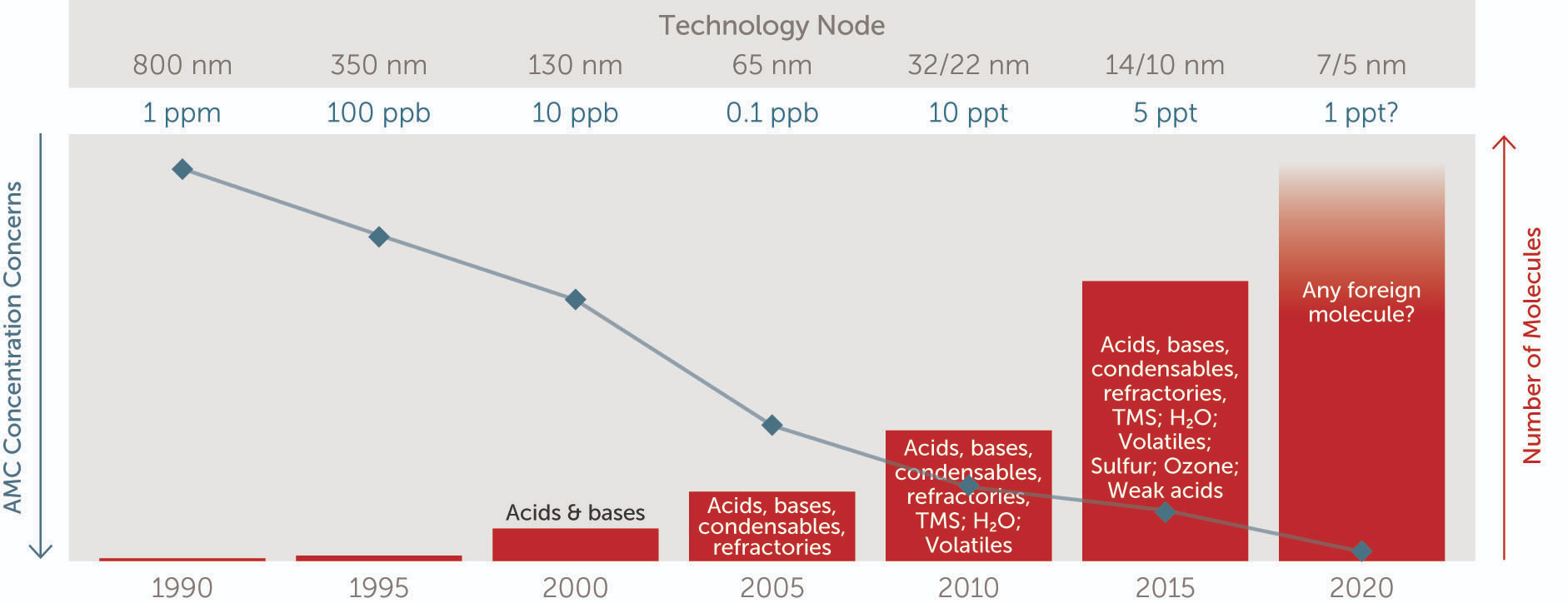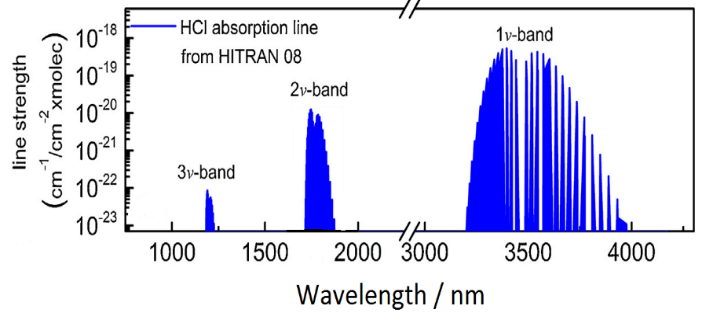Due to the continuing need to reduce chip sizes, it has become more and more critical for improved yield and reduced fab downtimes to control not only contamination by particulate matter but also by airborne molecular contaminants (AMCs), like HCl, NH3 and others.
Apart from frequently being a health hazard, AMCs clearly affect the yield of cleanroom fabrication facilities and result in fab downtimes and staggering losses. As per the international technology roadmap for semiconductors (ITRS) 20195, AMCs have been classified as an increasingly important class of contaminants in semiconductor fabrication facilities. These airborne volatile molecules can not be completely removed by modern filters in cleanroom fabs.
Primary reference gas mixtures (PRGMs) prepared by NMIs are used by ISO 17025 labs to generate calibration gas mixtures
AMCs include a wide variety of molecules and can range from small molecular contaminants such as acids and bases to larger organic molecules and it is a daunting task to measure and control each one of them. For instance, acidic species like HF and HCl are frequently used within etching processes in the cleanroom, while NH3 is easily emitted naturally in fairly high concentrations from the human skin and body.
Other AMC sources can be outgassing by preparation materials as well as polluted outside air and hence are difficult to control.
There is a lack of industry standards in filter testing, so customers must often choose a filter tailored to their needs, without the testing possibilities. Another relevant scenario is filter breakthrough after reaching the design lifetime of the expensive and short-lived chemical AMC filters. As a typical monitoring scenario, a rise of NH3 concentration from 6 to 20 nmol/mol due to a damaged filter, could necessitate a plant shut down to prevent production losses or quality issues. The loss of an entire wafer production lot can cost in millions of euros.

Therefore, there is a need to define standards for AMC levels that can be tolerated in cleanroom fabs at the ppb levels to prevent damaging the process and equipment and these are getting increasingly stringent year after year. The most recent specifications for AMC levels in cleanroom ambient air is such that, even parts-per-trillion levels have a significant effect. This generates an increasing need for accurate analytical techniques with measurement capabilities from the low parts per billion to the parts per trillion, monitoring these species in real time, with low uncertainties.
Comparing existing detection instruments
A new window has opened for cost-effective instruments which are sensitive to ppb levels and lower, as well as a need for improved accuracy and traceability to adhere to the strict industry standards.
Current industry-standard equipment for AMC monitoring (e.g. thermal-desorption-gas chromatography-mass spectrometry (TD-GC-MS), ion mobility spectroscopy, ion chromatography etc.) is fairly large, requires specifically trained personnel, slow in detection, less sensitive to lower concentration levels, concentration spikes, often lacks selectivity and is cost intensive to buy and operate.
For example, TD-GC-MS spectrometers are expensive to own and operate, the typical response time is 30 minutes or longer and are not sensitive to acids and bases. Ion mobility spectroscopy often has issues of poor chemical selectivity and need frequent calibration. Moreover, reference standards are lacking for providing high accuracy quality AMC data and calibration of instruments to industry standards.
Optical gas standards (OGS) provide traceable solutions independent of the existence of bottled reference gas mixtures
Laser-based detection techniques could open new possibilities to provide for significantly reduced costs, real-time detection, reduced operational complexity, as well as metrological traceability to adhere to the standards.
Though the technology for monitoring non-reactive species is well advanced, online monitoring of chemically reactive components like acids (e.g HF and HCl), very strongly adsorbing species (like NH3) or high molecular weight volatile organics is challenging due to critical issues related to the sampling process. These are caused by stickiness, adsorption to the inner surface area of sample tubing, chemical reactions along the sample path and cross-species interferences in combination with ultra-low concentrations.
From the principle of common denomination, as the concentration of one AMC class diminishes, the need to remove the next AMC class increases. Hence, even monitoring one class of AMCs is highly critical. For reactive species such as HCl, virtually neither standard equipment nor gaseous calibration standards are readily available, to calibrate and periodically validate these instruments.
The European research project METAMCII aims to address these issues by developing a measurement infrastructure for key AMC species.
The project
Following the success of its predecessor project METAMC, the MetAMC-II project was commissioned in 2018 to further develop spectroscopic instrumentation and reference standards for corrosive AMCs such as HCl and NH3, to enable accurate and traceable measurements adhering to the need for better standards. The project includes eight partners comprising of six national metrology institutes and two industrial partners specialising in commercial laser-based gas analysers.
Dynamic preparation methods are necessary for direct generation of AMCs gas standards at 1 μmol/mol (ppm) or less. However, the earlier dynamic preparation units were bulky which prevented them from being transported from the NMI sites for field calibration. One of the aims of the project has also been to develop traceable dynamic reference setups and materials of HCl for field calibration. The project also aims research into better sampling practices, gas preparation methods as well as validation of the static and dynamic gas standards at different NMI sites and inter-comparison to show the comparability of the measurement or preparation techniques reach a consensus.

The ultra-sensitive laser gas analysers developed in this project will be used to conduct field tests according to specifications obtained from a survey among stakeholders such as the semiconductor fabrication community and measurement equipment manufacturer.
MetAMCII partner, German national metrology institute Physikalisch-Technische Bundesanstalt (PTB) for example, is working on an advanced diode laser-based absorption spectrometer, one of the ultra-sensitive methods for measurement of HCl gas, using the principle of time-division-multiplexed dTDLAS and WMS, together with a Herriott-type multipass cell.
The spectrometer offers the advantage of cost effectiveness, low maintenance, real-time detection and improved species selectivity compared to the other methods such as GC-MS, as well as accurate and traceable measurements at the low amount fractions (ppb to ppt levels) found in cleanroom fabs. Research is being carried out to improve the sensitivity and stability of the spectrometer using test gas mixtures.
PTB is promoting the novel concept of Optical Gas Standards (OGS) which circumvents the need to refer to gaseous reference materials currently required for regular instrument calibration at accredited laboratories to facilitate accurate and comparable AMC measurements. This drastically reduces the cost of ownership as well as downtimes and helps cleanroom communities to reference AMC production levels to novel, non-gaseous transfer standards, which would foster increased yields and accurate performance evaluations.
An optical gas standard (OGS) is an absolute, first- principles spectrometer which, using a set of metrologically validated protocols, measures accurate and traceable AMC amount fractions. Optical gas standards are becoming even more relevant for highly reactive gas species such as HCl which are difficult to handle and store and which have no bottled gaseous standards with an acceptable uncertainty at the concentrations measured in cleanrooms.
Robust infrastructure
The project aims at a robust measurement infrastructure for key AMC species, mainly HCl and NH3 at the parts-per-billion levels. The main impact of the project will be towards ultra-sensitive measurements techniques and HCl gas standards, addressed beneficiaries will be instrument manufacturers and end-users such in the microelectronics and cleanroom communities.
An inter-comparison campaign within the course of the project seeks to validate the PTB OGS against new dynamic reference gas standards as well as new protocols and guidelines will be made available. The long-term focus will be towards the development of CMC services at PTB and other NMIs for critical AMCs.
On the more general scope and next to the advanced spectroscopy methods fit for purpose for AMC monitoring, the project will provide advanced calibration gas mixtures, improved gas storage, best preparation and sampling practices and measurement methods, compared methods of AMC measuring instruments, all of which help to underpin AMC level monitoring in cleanrooms providing accurate and reliable data.
IRTS guidelines for AMC monitoring in cleanrooms
- "There is clearly a need for better AMC monitoring instrumentation in the cleanroom to measure AMC at the part-per trillion level (by volume) in real time".
- Developments are urgently needed in order to improve manufacturing processes and to control contamination.
- Maintaining concentration levels of AMCs at ppb levels and below are critical for enhancing the yield and prevent downtime. The regulations are getting tougher by the day.
- AMCs generated as part of the production process need to be detectable at concentrations below 1 nmol/mol as these are detrimental to the product.




